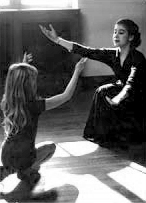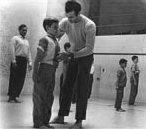A Legacy of Arts-Based Education
Adelphi has been a pioneer in arts-based education.
For several decades, The Children’s Center for the Creative Arts at Adelphi offered educators and artists from around the country a unique vision for a truly transformative learning experience. Despite the Center’s closing in the 1980s, its legacy continues to inform and inspire the University today.
 When Adelphi moved from Brooklyn to Garden City, New York in 1929, President Paul Dawson Eddy envisioned a campus community enlivened by meaningful interactions with some of the most influential artists of the day. In 1934, he invited Ruth St. Denis, the “First Lady of American Dance,” to establish one of the first dance program at an American university. Three years later, he recruited children’s theater pioneer Grace Stanistreet to establish the Adelphi College Children’s Theater and later, the Children’s Center for the Creative Arts. Following these women, a bright constellation of artists came together at the Center to experiment with learning and the creative process.
When Adelphi moved from Brooklyn to Garden City, New York in 1929, President Paul Dawson Eddy envisioned a campus community enlivened by meaningful interactions with some of the most influential artists of the day. In 1934, he invited Ruth St. Denis, the “First Lady of American Dance,” to establish one of the first dance program at an American university. Three years later, he recruited children’s theater pioneer Grace Stanistreet to establish the Adelphi College Children’s Theater and later, the Children’s Center for the Creative Arts. Following these women, a bright constellation of artists came together at the Center to experiment with learning and the creative process.
Deirdre Hurst du Prey, a founding member of the Michael Chekhov Acting Company, brought the acting methods developed at the experimental studios of the Moscow Arts Theater to children and adults in the Garden City community. Bruce King, a member of the Merce Cunningham Dance Company, offered students opportunities to express themselves through movement and rhythm. And Kitta Brown, a student of Jaques Dalcroze, brought the world renowned approach to music education known as Dalcroze Eurhythmics to students and teachers alike. (Mrs. Hurst du Prey recently donated much of her theater archives to the Adelphi library, which now joins Harvard University and the Lincoln Center Theater Library as stewards of these important materials documenting the formative years of modern theater history.)
Many of the Center’s programs foreshadowed later trends in arts education. Drama, music, dance, and the visual arts were explored across disciplines, and the creative process was understood to be equally as important as the finished product. The Center led the way in community service and outreach in the arts by offering workshops and performances for area children and adults. The intergenerational collaborations allowed young and old to explore the arts side by side, each learning from the others’ unique experiences.
 Adelphi and the Garden City community lost a vital resource when the Center closed in the mid-1980s. Despite the physical loss, the Center’s spirit lives on—and is being reinvigorated—at Adelphi today. Current faculty in education and the arts, with the support of administrators, are creating new ways to integrate the arts into education. In today’s age of educational standardization, a beacon of progressive arts-based learning is needed more than ever.
Adelphi and the Garden City community lost a vital resource when the Center closed in the mid-1980s. Despite the physical loss, the Center’s spirit lives on—and is being reinvigorated—at Adelphi today. Current faculty in education and the arts, with the support of administrators, are creating new ways to integrate the arts into education. In today’s age of educational standardization, a beacon of progressive arts-based learning is needed more than ever.
Through new curricula and courses, the College of Education and Health Sciences is ensuring that Adelphi remains a center for the arts in education. The school has infused new portions of its curriculum with fine arts and media studies and is offering an ever-expanding schedule of arts-based institutes and special programs. This is an exciting time in Adelphi’s history, and we hope you will join us in our efforts.